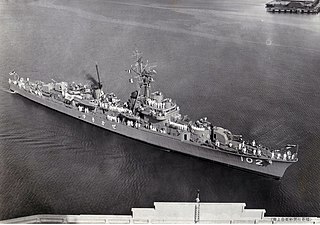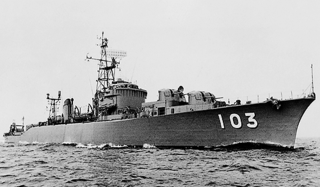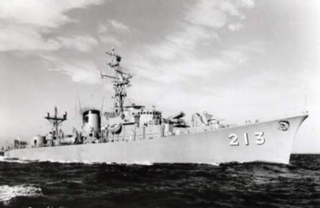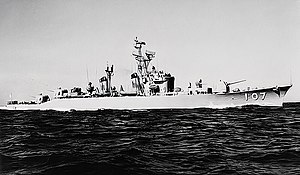
The Kongō class of guided missile destroyers in the Japan Maritime Self-Defense Force are equipped with the Aegis Combat System, and is the first of few ship classes outside the United States to have that capability. Following a decision made in December 2003, Japan is upgrading their Kongo-class destroyers with Aegis Ballistic Missile Defense System. The upgrade involves a series of installations and flight tests to take place from 2007 to 2010. JS Kongo was the first ship to have the BMD upgrade installed.

The Atago class of guided missile destroyers in the Japan Maritime Self-Defense Force is a modified version of the Kongō class equipped with the Aegis Combat System.

The Takanami-class destroyer is a class of destroyer serving with the Japan Maritime Self-Defense Force (JMSDF). This warship is the slightly modified class of second-generation, general-purpose destroyers of the JMSDF.

The Haruna-class destroyer was a destroyer class built for the Japan Maritime Self-Defense Force (JMSDF) in the early 1970s. These helicopter carrying destroyers (DDH) are built around a large central hangar which houses up to three helicopters.

The Tachikaze-class destroyer is a second generation guided missile destroyer class, formerly in service with the Japan Maritime Self-Defense Force (JMSDF). The ships of this class have had successive improvements after their completion, especially to their C4I systems. These air-defense warships are the natural successor to the first generation air-defense ship, the Amatsukaze-class destroyer, and they were in turn, followed by newer air-defense ships, the Hatakaze class.

The Asagiri-class destroyer is a class of destroyer, serving with the Japan Maritime Self-Defense Force (JMSDF). It was the second class of first generation general-purpose destroyers of the JMSDF.

JDS Amatsukaze (DDG-163) was a guided missile destroyer (DDG) of the Japan Maritime Self-Defense Force (JMSDF), and the only ship of her class. She was the first Japanese surface combatant equipped with surface-to-air missiles.

The Harukaze-class destroyer was the first indigenous post-World War II Japanese destroyer class. Its main mission was anti-submarine warfare.

The Ayanami class was a destroyer class built for the Japan Maritime Self-Defense Force (JMSDF) in the late 1950s. The primary purpose was anti-submarine warfare, so this class was classified as "DDK" unofficially.

The Akizuki-class destroyer was a destroyer class built for the Japan Maritime Self-Defense Force (JMSDF) in the late 1950s. This class was planned to be a flotilla leader with the enhanced command and control capability, so sometimes this class was classified as the "DDC" unofficially.

The Ikazuchi-class destroyer escort was a destroyer escort class built for the Coastal Safety Force in the late 1950s.

The Isuzu class destroyer escort was a destroyer escort class built for the Japan Maritime Self-Defense Force (JMSDF) in the early 1960s. The latter batch were quite different from the earlier two vessels in their propulsion and weaponry, so sometimes they were classified as the "Kitakami-class".

The Akizuki class of destroyers of the Japan Maritime Self-Defense Force is intended to escort the Hyūga-class and Izumo-class helicopter destroyers, and safeguard the other Aegis-capable warships such as the Kongō class and Atago class. The destroyer provides defense against surface, airborne and undersea threats. The class was initially designated as "19DD", referring to a date on the Japanese calendar, specifically the 19th fiscal year of the Heisei period (2007).

The OPS-24 is a shipborne three-dimensional air search radar adopting active electronically scanned array (AESA) technology.

JDS Ikazuchi (DE-202) is the lead ship of Ikazuchi-class destroyer escort of Japan Maritime Self-Defense Force.

JDS Inazuma (DE-203) is the second ship of the Ikazuchi-class destroyer escorts of the Japan Maritime Self-Defense Force (JMSDF).

JDS Isuzu (DE-211) is the lead ship of the Isuzu-class destroyer escorts of the Japan Maritime Self-Defense Force (JMSDF).

JDS Mogami (DE-212) is the second ship of Isuzu-class destroyer escort of Japan Maritime Self-Defense Force (JMSDF).

JDS Kitakami (DE-213) is the third ship of Ikazuchi-class destroyer escort of Japan Maritime Self-Defense Force.

JDS Ōi (DE-214) is the fourth ship of Isuzu-class destroyer escort of Japan Maritime Self-Defense Force.


















